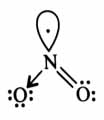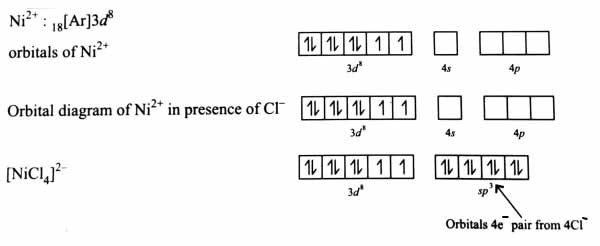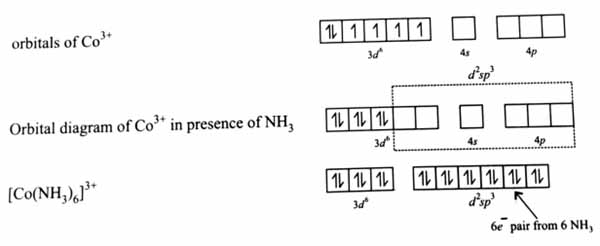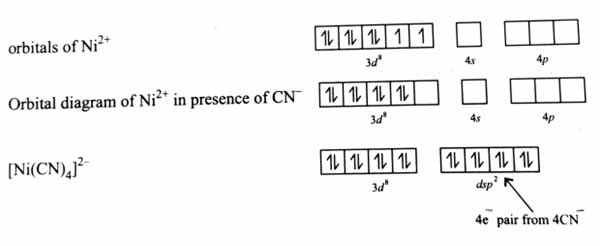Topic Question Set
Q 1
:
The correct statements from the following are: [2024]
A. The strength of anionic ligands can be explained by crystal field theory.
B. Valence bond theory does not give a quantitative interpretation of kinetic stability of coordination compounds.
C. The hybridization involved in the formation of complex is .
D. The number of possible isomer(s) of cis-is one.
Choose the correct answer from the options given below:
B, C only
A, C only
A, D only
B, D only
(1)
(A) Crystal field theory helps us in arranging the ligands in increasing order of their crystal field splitting strength.
(B) Valence bond theory does not give a quantitative interpretation of the thermodynamic or kinetic stabilities of coordination compounds.
(C)
Oxidation number of Ni = +2

is a strong field ligand, hence it causes pairing of electrons, then causes hybridization using 3d, 4s, and 4p orbitals.
(D) cis- has a pair of enantiomers.

Q 2
:
is the number of acidic oxides among and . The primary valency of cobalt in is Y.
The value of X + Y is: [2025]
5
4
2
3
(1)
| Oxide | Nature |
| Basic | |
| Basic | |
| Amphoteric | |
| Acidic | |
| Acidic, thus X = 2 |
Primary valency is oxidation state. Oxidation state of Co in is +3. So Y = 3. X + Y = 5.
Q 3
:
is the number of electrons in orbitals of the most stable complex ion among , and . The nature of oxide of vanadium of the type is: [2025]
Acidic
Neutral
Basic
Amphoteric
(4)
Because of chelation effect, is most stable. As is a weak field ligand, in splits as . Thus, has five unpaired electrons. is amphoteric.
Q 4
:
Total number of molecules/species from the following which will be paramagnetic is _________.
[2025]
(6)
| Species | Electronic configuration/structure | Magnetic nature |
| Paramagnetic | ||
| Paramagnetic | ||
| Paramagnetic | ||
| Paramagnetic | ||
 |
Paramagnetic | |
| Diamagnetic | ||
 |
Paramagnetic | |
 |
Diamagnetic | |
 |
Diamagnetic |
Q 5
:
A transition metal (M) among Mn, Cr, Co and Fe has the highest standard electrode potential . It forms a metal complex of the type . The number of electrons present in the orbital of the complex is ________. [2025]
(1)
Among Cr, Mn, Fe and Co, highest potential is of Co.
| Cr | Mn | Fe | Co | |
| (in V) | –0.41 | +1.57 | +0.77 | +1.97 |
Thus the complex is .
Oxidation number of Co = +2, . As is a strong field ligand, in octahedral field splits as . Number of electrons in is 1.

